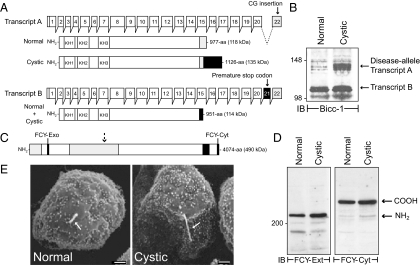Figure 1.
Conditionally immortalized cell lines from ARPKD mouse model. (A) The Bicc1 gene has 22 exons encoding two alternatively spliced transcripts (A and B) in mouse kidney. Predicted structures for normal and disease-specific protein products shown beneath each transcript highlight RNA-binding KH (K homology) domains, exon 21 and exon 22-encoded sequences (black and gray boxes, respectively), disease-specific carboxyl-terminal extension (hatched box), and predicted molecular weights (in parenthesis). Adapted from Cogswell et al. (2003). (B) Equal protein aliquots were immunoblotted with Bicc1 antibody. (C) Predicted fibrocystin domain structure highlighting extracellular immunoglobulin-like TIG repeats (light gray box), transmembrane domain (hatched box), FCY-Exo and FCY-Cyt peptide antibody sequences (black box), and approximate cleavage site generating major endogenous protein species (dashed arrow). (D) Equal protein aliquots were immunoblotted with fibrocystin antibodies (FCY-Ext and FCY-Cyt described in text). (E) Cells were examined by scanning electron microscopy. Arrow, central primary cilia. Scale bar, 1 μm; magnification, ×3000.

